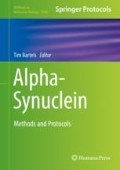Abstract
Accumulation of misfolded αSyn and mitochondrial dysfunction are central features of Parkinson’s disease. Growing evidence points to a relationship between these two phenomena as oligomeric α-synuclein (αSyn) can interact with mitochondria and impair their function. Standardization of methods to prepare αSyn oligomers and isolate functional mitochondria will facilitate efforts to expand upon early findings. Here we present detailed protocols for preparing soluble αSyn oligomers; for isolating functional mitochondria from mouse tissue; and for simultaneously measuring several aspects of mitochondrial physiology. These protocols will benefit future studies aimed at characterizing the mitotoxicity of αSyn species isolated from the brains of synucleinopathy patients as well as efforts to identify small molecules and genetic or environmental alterations that prevent αSyn-induced mitochondrial dysfunction.
Access this chapter
Tax calculation will be finalised at checkout
Purchases are for personal use only
References
Bartels T, Choi JG, Selkoe DJ (2011) α-Synuclein occurs physiologically as a helically folded tetramer that resists aggregation. Nature 477:107–110
Westphal CH, Chandra SS (2013) Monomeric synucleins generate membrane curvature. J Biol Chem 288:1829–1840
Luth ES, Bartels T, Dettmer U et al (2015) Purification of α-synuclein from human brain reveals an instability of endogenous multimers as the protein approaches purity. Biochemistry 54:279–292
Gould N, Mor DE, Lightfoot R et al (2014) Evidence of native α-synuclein conformers in the human brain. J Biol Chem 289:7929–7934
Wang L, Das U, Scott DA et al (2014) α-Synuclein multimers cluster synaptic vesicles and attenuate recycling. Curr Biol 24:2319–2326
Iljina M, Tosatto L, Choi ML et al (2016) Arachidonic acid mediates the formation of abundant alpha-helical multimers of alpha-synuclein. Sci Rep 6:33928
Chartier-Harlin M-C, Kachergus J, Roumier C et al (2004) Alpha-synuclein locus duplication as a cause of familial Parkinson’s disease. Lancet (London, England) 364:1167–1169
Singleton AB, Farrer M, Johnson J et al (2003) Alpha-Synuclein locus triplication causes Parkinson’s disease. Science 302:841–841
Kara E, Lewis PA, Ling H et al (2013) α-Synuclein mutations cluster around a putative protein loop. Neurosci Lett 546:67–70
Spillantini MG, Schmidt ML, Lee VM et al (1997) Alpha-synuclein in Lewy bodies. Nature 388:839–840
Dettmer U, Newman AJ, Soldner F et al (2015) Parkinson-causing α-synuclein missense mutations shift native tetramers to monomers as a mechanism for disease initiation. Nat Commun 6:7314
Danzer KM, Haasen D, Karow AR et al (2007) Different species of alpha-synuclein oligomers induce calcium influx and seeding. J Neurosci 27:9220–9232
Winner B, Jappelli R, Maji SK et al (2011) In vivo demonstration that alpha-synuclein oligomers are toxic. Proc Natl Acad Sci U S A 108:4194–4199
Karpinar DP, Balija MBG, Kügler S et al (2009) Pre-fibrillar alpha-synuclein variants with impaired beta-structure increase neurotoxicity in Parkinson’s disease models. EMBO J 28:3256–3268
Volles MJ, Lansbury PT (2003) Zeroing in on the pathogenic form of alpha-synuclein and its mechanism of neurotoxicity in Parkinson’s disease. Biochemistry 42:7871–7878
Fusco G, Chen SW, Williamson PTF et al (2017) Structural basis of membrane disruption and cellular toxicity by α-synuclein oligomers. Science 358:1440–1443
Schapira AH, Cooper JM, Dexter D et al (1989) Mitochondrial complex I deficiency in Parkinson’s disease. Lancet (London, England) 1:1269
Parker WD, Boyson SJ, Parks JK (1989) Abnormalities of the electron transport chain in idiopathic Parkinson’s disease. Ann Neurol 26:719–723
Keeney PM, Xie J, Capaldi RA et al (2006) Parkinson’s disease brain mitochondrial complex I has oxidatively damaged subunits and is functionally impaired and misassembled. J Neurosci 26:5256–5264
Devi L, Raghavendran V, Prabhu BM et al (2008) Mitochondrial import and accumulation of alpha-synuclein impair complex I in human dopaminergic neuronal cultures and Parkinson disease brain. J Biol Chem 283:9089–9100
Martin LJ, Pan Y, Price AC et al (2006) Parkinson’s disease alpha-synuclein transgenic mice develop neuronal mitochondrial degeneration and cell death. J Neurosci 26:41–50
Stichel CC, Zhu X-R, Bader V et al (2007) Mono- and double-mutant mouse models of Parkinson’s disease display severe mitochondrial damage. Hum Mol Genet 16:2377–2393
Hsu LJ, Sagara Y, Arroyo A et al (2000) Alpha-synuclein promotes mitochondrial deficit and oxidative stress. Am J Pathol 157:401–410
Büttner S, Habernig L, Broeskamp F et al (2013) Endonuclease G mediates α-synuclein cytotoxicity during Parkinson’s disease. EMBO J 32:3041–3054
Parihar MS, Parihar A, Fujita M et al (2009) Alpha-synuclein overexpression and aggregation exacerbates impairment of mitochondrial functions by augmenting oxidative stress in human neuroblastoma cells. Int J Biochem Cell Biol 41:2015–2024
Shavali S, Brown-Borg HM, Ebadi M et al (2008) Mitochondrial localization of alpha-synuclein protein in alpha-synuclein overexpressing cells. Neurosci Lett 439:125–128
Luth ES, Stavrovskaya IG, Bartels T et al (2014) Soluble, prefibrillar α-synuclein oligomers promote complex I-dependent, Ca2+-induced mitochondrial dysfunction. J Biol Chem 289:21490–21507
Luk KC, Song C, O’Brien P et al (2009) Exogenous alpha-synuclein fibrils seed the formation of Lewy body-like intracellular inclusions in cultured cells. Proc Natl Acad Sci U S A 106:20051–20056
Volpicelli-Daley LA, Luk KC, Patel TP et al (2011) Exogenous α-synuclein fibrils induce Lewy body pathology leading to synaptic dysfunction and neuron death. Neuron 72:57–71
Luk KC, Kehm V, Carroll J et al (2012) Pathological α-synuclein transmission initiates Parkinson-like neurodegeneration in nontransgenic mice. Science 338:949–953
Polinski NK, Volpicelli-Daley LA, Sortwell CE et al (2018) Best practices for generating and using alpha-Synuclein pre-formed fibrils to model Parkinson’s disease in rodents. J Parkinson’s Dis 68:1–20
Stavrovskaya IG, Baranov SV, Guo X et al (2010) Reactive gamma-ketoaldehydes formed via the isoprostane pathway disrupt mitochondrial respiration and calcium homeostasis. Free Radic Biol Med 49:567–579
Author information
Authors and Affiliations
Corresponding author
Editor information
Editors and Affiliations
Rights and permissions
Copyright information
© 2019 Springer Science+Business Media, LLC, part of Springer Nature
About this protocol
Cite this protocol
Luth, E.S., Stavrovskaya, I.G. (2019). Measuring Mitochondrial Dysfunction Caused by Soluble α-Synuclein Oligomers. In: Bartels, T. (eds) Alpha-Synuclein. Methods in Molecular Biology, vol 1948. Humana Press, New York, NY. https://doi.org/10.1007/978-1-4939-9124-2_14
Download citation
DOI: https://doi.org/10.1007/978-1-4939-9124-2_14
Published:
Publisher Name: Humana Press, New York, NY
Print ISBN: 978-1-4939-9123-5
Online ISBN: 978-1-4939-9124-2
eBook Packages: Springer Protocols

